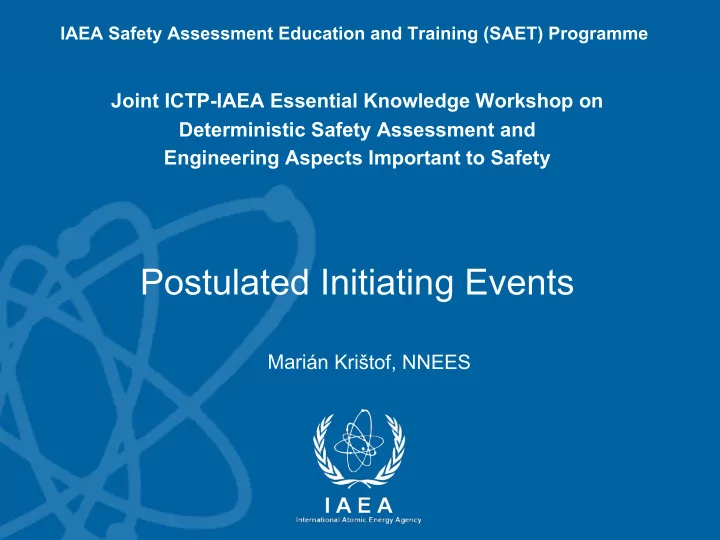

IAEA Safety Assessment Education and Training (SAET) Programme Joint ICTP-IAEA Essential Knowledge Workshop on Deterministic Safety Assessment and Engineering Aspects Important to Safety Postulated Initiating Events Marián Kri š tof, NNEES
Session Outline n PIEs in IAEA SS o Regulatory perspective o Design perspective o Safety analysis perspective n Identification of PIEs n Grouping of PIEs n Examples n Categorization n Regulatory review 2
Steps of safety analysis n Scope of the analysis o Type of facility o PIE o Acceptance criteria n Approach o Definition of methodology n Selection of appropriate computer code and construction of the input model (V&V) n Assumptions o Definition of boundary and initial conditions (BIC) o Availability of systems and components o Single failure o Operator action n Analysis and evaluation of the results 3 Taken from IAEA SRS no. 23
Postulated initiating events n An initiating event is an event that creates a disturbance in the plant and has a potential to lead to core damage, depending on the successful operation of the various mitigating systems of the plant n The starting point for the safety analysis is the set of postulated initiating events that need to be addressed. A PIE is defined as an “identified event that leads to anticipated operational occurrences or accident conditions”. PIEs include events such as equipment failure, human errors and human induced or natural external events (hazards). The deterministic safety analysis and the PSA should normally use a common set of PIEs 4
PIE – regulatory perspective (GS-G-1.2) n The identification of the PIEs which should be taken into account in the safety analysis is the IAEA first step in the review and assessment process SAFETY ST ANDARDS SERIES n The method used should be systematic and auditable Review and Assessment of Nuclear Facilities by the Regulatory Body n Moreover, as complete as possible a listing of PIEs should be provided SAFETY GUIDE n An important feature of the review and No. GS-G-1.2 INTERNATIONAL ATOMIC ENERGY AGENCY VIENNA assessment process should be considering whether the operator’s method of identification meets these requirements and whether the operator’s list of PIEs is acceptable as the basis for the safety analysis 5
PIE – regulatory perspective (GS-G-1.2) n PIEs can be grouped in various ways. One commonly used method is to separate them into: IAEA o External hazards, which are outside the control of the operator and may result SAFETY ST ANDARDS from natural or human made causes such as a seismic event, an aircraft crash or SERIES an explosion of flammable liquid gas in transport o Internal faults that result from inherent failures of the facility, such as mechanical Review and Assessment or electrical failures or loss of services of Nuclear Facilities by the Regulatory Body o Internal hazards such as fire or spillage of corrosive material resulting from failures of systems that are within the operator’s control but are not directly SAFETY GUIDE considered in the review and assessment process No. GS-G-1.2 n Consideration should also be given to human errors, which may be INTERNATIONAL ATOMIC ENERGY AGENCY VIENNA initiators in their own right or may exacerbate a fault n It is usual to classify the PIEs relating to internal faults according to the initiating frequencies of the PIEs and their potential consequences. The purpose of such a classification is to help decide on the type and level of analysis that should be undertaken 6
PIE – design perspective (SSR-2/1) n The design for the nuclear power plant shall apply a systematic approach to identifying a comprehensive set of postulated initiating events such that ��������������������� all foreseeable events with the potential for serious consequences and all �������������������������������������� ����������������������������������������� foreseeable events with a significant frequency of occurrence are ����������� �������������������������������������������������������������� anticipated and are considered in the design ������� ����� �������� ��������� ���� ���������� �������� ���� ����� ���������������������������������������� �������������� ������� ���� ����������� ���� ����� ������� ���������� ���� ����������������������� ��������� ��� ����������� ������ ���� �� ���������� ���� ������� ������� ��� ������������������ o The postulated initiating events shall be identified on the basis of engineering ������ ������������ ���������������� judgement and a combination of deterministic assessment and probabilistic assessment ���������������������������� o The postulated initiating events shall include all foreseeable failures of structures, ����������� systems and components of the plant, as well as operating errors and possible ���������������������������������� ������ failures arising from internal and external hazards, whether in full power, low ������������ ����������� �������������� power or shutdown states ����������������������������� ��������������������� o An analysis of the postulated initiating events for the plant shall be made to establish the preventive measures and protective measures that are necessary to ensure that the required safety functions will be performed 7
PIE – design perspective (SSR-2/1) n The expected behaviour of the plant in any postulated initiating event shall be such that the following conditions can be ��������������������� achieved, in order of priority: �������������������������������������� ����������������������������������������� (1) A postulated initiating event would produce no safety significant effects or would produce only a change towards safe plant ����������� �������������������������������������������������������������� ������� ����� �������� ��������� ���� ���������� �������� ���� ����� ���������������������������������������� �������������� ������� ���� ����������� ���� ����� ������� ���������� ���� ����������������������� ��������� ��� ����������� ������ ���� �� ���������� ���� ������� ������� ��� conditions by means of inherent characteristics of the plant ������������������ ������ ������������ ���������������� (2) Following a postulated initiating event, the plant would be rendered safe by means of passive safety features or by the action of systems that are operating continuously in the state necessary ���������������������������� ����������� to control the postulated initiating event ���������������������������������� (3) Following a postulated initiating event, the plant would be ������ ������������ ����������� �������������� rendered safe by the actuation of safety systems that need to be ����������������������������� ��������������������� brought into operation in response to the postulated initiating event (4) Following a postulated initiating event, the plant would be rendered safe by following specified procedures 8
Recommend
More recommend